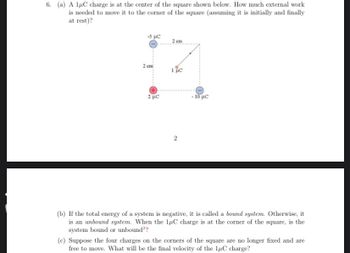Question

Transcribed Image Text:6. (a) A 1μC charge is at the center of the square shown below. How much external work
is needed to move it to the corner of the square (assuming it is initially and finally
at rest)?
-5 με
2 cm
2 με
2 cm
1 μC
2
- 10 με
(b) If the total energy of a system is negative, it is called a bound system. Otherwise, it
is an unbound system. When the 1μC charge is at the corner of the square, is the
system bound or unbound??
(c) Suppose the four charges on the corners of the square are no longer fixed and are
free to move. What will be the final velocity of the 1μC charge?
Expert Solution
This question has been solved!
Explore an expertly crafted, step-by-step solution for a thorough understanding of key concepts.
Step by stepSolved in 3 steps

Knowledge Booster
Similar questions
- (a) How much charge can be placed on a capacitor with air between the plates before it breaks down if the area of each plate is 9.00 cm²? nC (b) Find the maximum charge if nylon is used between the plates instead of air. nCarrow_forwardWrite this in decimal format. Do not use scientific notationarrow_forwardThe nucleus of a helium atom contains two protons that are approximately 1 fm apart. How much work must be done by an external agent to bring the two charges from an infinite separation to a separation of 1.0 fm? -230 J -2.3 x 10-13 J 2.3 x 10-13 j 2.3 x 10-16 Jarrow_forward
- Please type clear thank youarrow_forwardAn immovable charge Q₁ = +2.0µC is placed in fixed location at the origin on an (x, y) coordinate system. Another charge, Q₂ = +4.0μC is allowed to move near the first charge. How much work does it take to move this charge from it's starting location of (-3cm, 4cm) to the following locations and if the time to make this change is 10 ms how much power was output during each process: (a) (-1.5cm, 2cm) (b) (-6cm, 8cm) (c) (3cm, 4cm)arrow_forwardpls help me answer these questions and showcase all your workarrow_forward
- Points A and B are 40 and 25 mm away from a 6 μC charge, how much work is necessary to do against the electric field (through external forces) to move a 5 μC charge from point A to point B?arrow_forwardQuestion 1 Consider two charges +q and +3q. There original distance is d. How much work is needed to bring +3q to a distance d/2? 1 W ext 4πεο O 3q^2 (1/d) -3q^2 (1/d) 3q (1/d) -3q (1/d)arrow_forward
arrow_back_ios
arrow_forward_ios